Related Research Articles
The Able was a small French cyclecar made in Avignon by Paul Toulouse, built between 1920 and 1927.
The Ajams was a French automobile, built in Neuilly by M. Ajams in 1920. A light cyclecar, it had a tubular frame in the "birdcage" style. Its engine was a 1093 cc water-cooled twin-cylinder 9hp unit with a three-speed gearbox. It also had independent suspension for all for wheels.
The Amazon was a cyclecar produced by Amazon Cars Ltd in Billiter Street, London, EC3, England from 1921 to 1922.
The Cricket was an American cyclecar manufactured in Detroit, Michigan, by the Cricket Cyclecar Company in 1914. It was a small cyclecar driven by a two-cylinder engine with a two-speed transmission. The vehicle sold for $385. The company combined in late 1914 with the Motor Products Company, who manufactured motorcycles.
The Dodge was a cyclecar manufactured in Detroit, Michigan, by the A.M. Dodge Company from 1914 to 1915. The cyclecar had a four-cylinder 25 hp engine that was water-cooled, and had a frictionless transmission. The vehicle was designed by George Wahl of Wahl Motor Company. The company was later sued by the Dodge brothers in 1915, who claimed that their name had been infringed.
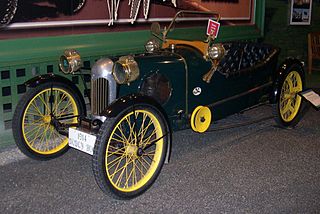
The Dudly was a Brass Era, gas-powered cyclecar manufactured in Menominee, Michigan, by the Dudly Tool Company from 1913 to 1915. The Dudly had an ash-wood frame, two-seater open model that was originally offered with a two-cylinder air-cooled engine. The 1914 Dudly was offered with a four-cylinder 1.6 L engine.
The Engler was an American cyclecar manufactured in Pontiac, Michigan by the W.B. Engler Cyclecar Company from 1914 to 1915. The Engler was a two-seater cyclecar that used a DeLuxe air-cooled, a 1.2L two-cylinder engine. The vehicle had a friction transmission and belts, and cost $385.
The Excel was an American cyclecar manufactured in Detroit, Michigan by the Excel Distributing Company in 1914. The two-seater cyclecar weighed 1,000 lb (450 kg), and had a 1.5 L water-cooled four-cylinder engine. It was driven by a friction transmission with belts.
The Hawk was an American cyclecar built in Detroit, Michigan by the Hawk Cyclecar Company in 1914. The Hawk was belt-driven with a 9/13 hp V-twin engine. The vehicle was advertised for $390, and could seat two passengers side-by-side. It had a distinctive sloping bonnet line.

The JPL was a brass era cyclecar built in Detroit, Michigan by the J.P.L. Cyclecar Company, formed in 1913. Production started in December 1913 but ended in 1914.
The American was a cyclecar made by American Cyclecar Co. of Detroit, Michigan in 1914. It had a 4-cylinder engine of 1.2 liters, and featured a friction transmission and chain drive. The headlights were inserted into the fenders, a feature later associated with the Pierce-Arrow. The make was superseded by the Trumbull.

The Campion Cycle Company was a British bicycle, cyclecar and motor cycle maker, active from 1893 to 1926 and based in Nottingham, England. In 1927 it was purchased by Currys.
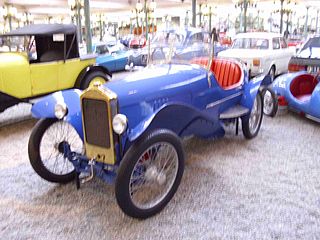
Sénéchal was a French automobile manufacturer between 1921 and 1929.

Sima Violet was a French manufacturer of cyclecars between 1924 and 1929.
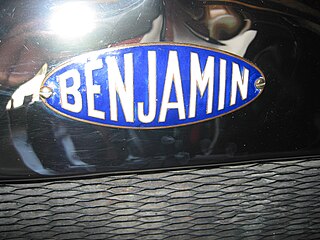
Benjamin was a French manufacturer of cyclecars between 1921 and 1927 and based on the north-west edge of Paris. 1927 was a year of changes which included a name change, and between 1927 and 1929 the company operated under a new name, Benova.
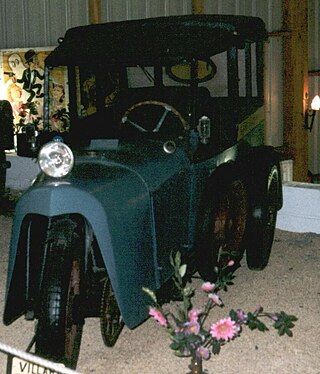
Villard was a French automobile manufacturer between 1925 and 1935.
Raymond Siran, Cyclecars D'Yrsan was a French manufacturer of automobiles in the cyclecar class.

The Saginaw cyclecar was built by the Valley Boat & Engine Company of Saginaw, Michigan in 1914.
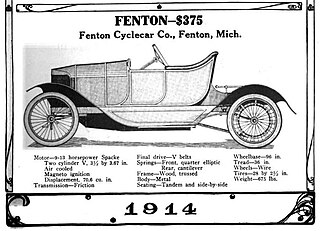
The Signet cyclecar was the name used by Fenton Engineering Company of Fenton, Michigan from 1913 to 1914. In 1914 the name was changed to Fenton and was manufactured by the Fenton Cyclecar Company. In May 1914, The Fenton became the Koppin and was produced by the Koppin Motor Company until September 1914.
The Tiger was a cyclecar built by the Automobile Cyclecar Co. of Detroit, Michigan, in 1914. The Tiger was manufactured as both a 2-seater and a 4-seater car, and was powered by a 4-cylinder Farmer engine with overhead valves and a drive shaft.
References
- ↑ "Car History 4U - Special Features / Cyclecars". Archived from the original on 22 June 2011. Retrieved 13 January 2011.
- ↑ Georgano, G. N., ed. (1968). The Complete Encyclopaedia of Motorcars 1885-1968. Ebury Press. p. 68.
- ↑ Georgano, G.N. (2000). Beaulieu Encyclopedia of the Automobile. London: HMSO. ISBN 1-57958-293-1.[ page needed ]